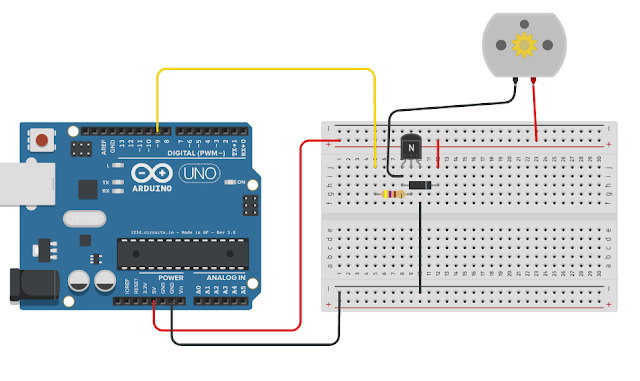Wednesday, June 7, 2017
PWM Motor Drive
CODE FOR PWM DRIVE
int motor = 9;
int speed = 0;
void setup() {
pinMode(motor, OUTPUT);
}
void loop() {
analogWrite(motor, speed);
speed = speed + 31;
if (speed > 250)
{
speed = 255;
}
delay(4000);
if (speed > 250)
{
speed = 0;
}
}
Monday, June 5, 2017
Seven Segment Display Numbers
Code for driving segment display. To drive a common cathode the NOT operator ! must be removed from the front of the array in the highlighted part of the code.
//
make an array to save Sev Seg pin configuration of numbers
int
num_array[10][7] = { { 1,1,1,1,1,1,0
}, // 0
{ 0,1,1,0,0,0,0
}, // 1
{ 1,1,0,1,1,0,1
}, // 2
{ 1,1,1,1,0,0,1
}, // 3
{ 0,1,1,0,0,1,1
}, // 4
{ 1,0,1,1,0,1,1
}, // 5
{ 1,0,1,1,1,1,1
}, // 6
{ 1,1,1,0,0,0,0
}, // 7
{ 1,1,1,1,1,1,1
}, // 8
{ 1,1,1,0,0,1,1
}}; // 9
//function
header
void
Num_Write(int);
void
setup()
{
// set pin modes
pinMode(6, OUTPUT);
pinMode(7, OUTPUT);
pinMode(8, OUTPUT);
pinMode(9, OUTPUT);
pinMode(10, OUTPUT);
pinMode(11, OUTPUT);
pinMode(12, OUTPUT);
}
void
loop()
{
for (int counter = 10; counter > 0;
--counter)
{
delay(1000);
Num_Write(counter-1);
}
delay(5000);
}
//
this functions writes values to the sev seg pins
void
Num_Write(int number)
{
int pin= 6;
for (int j=0; j < 7; j++) {
digitalWrite(pin, !num_array[number][j]);
//Inverted array value due to Common Anode display
pin++;
}
}
Common Anode Seven-Segment Display Test
// 7 Segment test
void setup()
{
// define pin modes
pinMode(6,OUTPUT);
pinMode(7,OUTPUT);
pinMode(8,OUTPUT);
pinMode(9,OUTPUT);
pinMode(10,OUTPUT);
pinMode(11,OUTPUT);
pinMode(12,OUTPUT);
}
void loop()
{
for(int i=6;i<13;i++) //Clear LEDs since the outputs start LOW (LED ON)
{
digitalWrite(i,HIGH);
delay(1);
}
// loop to turn leds segments ON by sinking them (taking pins to GND)
for(int i=6;i<13;i++)
{
digitalWrite(i,LOW);
delay(600);
}
// loop to turn leds segnemts OFF by taking the pins to V+
for(int i=6;i<13;i++)
{
digitalWrite(i,HIGH);
delay(600);
}
delay(1000);
}
Tuesday, May 30, 2017
PWM Motor Control
PWM Motor Code
This code makes the motor speed up until it reaches the highest speed possible and then it resets to low speed again.
------------------------
int motor = 9;
int speed = 0;
void setup() {
pinMode(motor, OUTPUT);
}
void loop() {
analogWrite(motor, speed);
speed = speed + 31;
if (speed > 250)
{
speed = 255;
}
delay(4000);
if (speed > 250)
{
speed = 0;
}
}
Wednesday, May 24, 2017
Target Game
Hook up the following circuit starting with the servo first.
int sensorPin = A0;
int ledPin = 13;
int sensorValue;
#include <Servo.h>
Servo myservo;
void setup()
{
myservo.attach(9);
pinMode(ledPin, OUTPUT);
//Serial.begin(9600);
}
void loop()
{
sensorValue = analogRead(sensorPin);
//Serial.println(sensorValue); // Print value to monitor
analogWrite(ledPin, sensorValue);
if (sensorValue < 100)
{
myservo.write(180); // tell servo to go to position in variable 'pos'
delay(15);
}
else
{
myservo.write(90);
delay(2000);
}
}
Subscribe to:
Comments (Atom)




